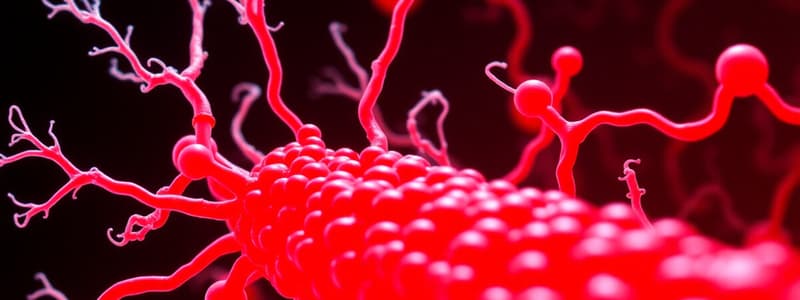Podcast
Questions and Answers
The Golgi apparatus only transports proteins from the Golgi to the plasma membrane.
The Golgi apparatus only transports proteins from the Golgi to the plasma membrane.
False (B)
O-linked glycosylation occurs in the Golgi and involves the addition of sugars to Serine and Threonine residues.
O-linked glycosylation occurs in the Golgi and involves the addition of sugars to Serine and Threonine residues.
True (A)
COP 1 and COP 2 proteins are involved in transport processes in the Golgi.
COP 1 and COP 2 proteins are involved in transport processes in the Golgi.
True (A)
A defect in the enzyme N-acetylglucosaminyl-1-phosphotransferase leads to proper lysosomal degradation of cellular waste.
A defect in the enzyme N-acetylglucosaminyl-1-phosphotransferase leads to proper lysosomal degradation of cellular waste.
Signal Recognition Particle (SRP) dysfunction causes proteins to accumulate in the endoplasmic reticulum.
Signal Recognition Particle (SRP) dysfunction causes proteins to accumulate in the endoplasmic reticulum.
Mannose-6-phosphate is added to proteins in the Golgi to mark them for delivery to lysosomes.
Mannose-6-phosphate is added to proteins in the Golgi to mark them for delivery to lysosomes.
Clathrin is responsible for transporting vesicles from endosomes to the cytosol.
Clathrin is responsible for transporting vesicles from endosomes to the cytosol.
Severe joint and bone abnormalities can be a presentation of a lysosomal storage disorder.
Severe joint and bone abnormalities can be a presentation of a lysosomal storage disorder.
The Golgi apparatus is responsible for transporting proteins and lipids from the ER to lysosomes.
The Golgi apparatus is responsible for transporting proteins and lipids from the ER to lysosomes.
O-linked glycosylation exclusively occurs in the endoplasmic reticulum.
O-linked glycosylation exclusively occurs in the endoplasmic reticulum.
Mannose-6-phosphate is essential for the proper targeting of lysosomal enzymes to their respective organelles.
Mannose-6-phosphate is essential for the proper targeting of lysosomal enzymes to their respective organelles.
A defect in N-acetylglucosaminyl-1-phosphotransferase can lead to the degradation of cellular waste.
A defect in N-acetylglucosaminyl-1-phosphotransferase can lead to the degradation of cellular waste.
COP 2 is involved in the retrograde transport of materials from the Golgi to the ER.
COP 2 is involved in the retrograde transport of materials from the Golgi to the ER.
Clathrin is involved in transporting vesicles from the trans-Golgi to lysosomes.
Clathrin is involved in transporting vesicles from the trans-Golgi to lysosomes.
The signal recognition particle (SRP) directs proteins to the cytosol for modifications.
The signal recognition particle (SRP) directs proteins to the cytosol for modifications.
Lysosomal storage disorders can lead to the accumulation of undigested substances within cells.
Lysosomal storage disorders can lead to the accumulation of undigested substances within cells.
Flashcards
What is the role of the Golgi apparatus in cellular transport?
What is the role of the Golgi apparatus in cellular transport?
The Golgi apparatus is a central distribution center for proteins and lipids, responsible for transporting them from the endoplasmic reticulum (ER) to vesicles, the plasma membrane, and other cellular compartments. It acts as a processing plant, modifying and sorting proteins and lipids before sending them to their final destination.
What is N-linked glycosylation?
What is N-linked glycosylation?
N-linked glycosylation involves the addition of sugar chains to asparagine residues on proteins. It begins in the ER and continues in the Golgi, where these sugar chains are modified to form complex or hybrid glycan structures.
What is O-linked glycosylation?
What is O-linked glycosylation?
O-linked glycosylation involves the addition of sugar chains directly to serine or threonine residues on proteins. This modification takes place exclusively in the Golgi and is crucial for functions like mucus production and cell-cell interactions.
What is the function of Mannose-6-phosphate (M6P)?
What is the function of Mannose-6-phosphate (M6P)?
Signup and view all the flashcards
What is the function of COP 1?
What is the function of COP 1?
Signup and view all the flashcards
What is the function of COP 2?
What is the function of COP 2?
Signup and view all the flashcards
What is the function of Clathrin?
What is the function of Clathrin?
Signup and view all the flashcards
What is the consequence of a defect in the N-acetylglucosaminyl-1-phosphotransferase enzyme?
What is the consequence of a defect in the N-acetylglucosaminyl-1-phosphotransferase enzyme?
Signup and view all the flashcards
What is the Golgi apparatus and what is its role in cell trafficking?
What is the Golgi apparatus and what is its role in cell trafficking?
Signup and view all the flashcards
What is mannose-6-phosphate (M6P) and its function?
What is mannose-6-phosphate (M6P) and its function?
Signup and view all the flashcards
What is COP 1 and its role?
What is COP 1 and its role?
Signup and view all the flashcards
What is COP 2 and its role?
What is COP 2 and its role?
Signup and view all the flashcards
What is clathrin and its role?
What is clathrin and its role?
Signup and view all the flashcards
Study Notes
Golgi Function and Trafficking
- The Golgi apparatus is a central distribution center for transporting proteins and lipids from the endoplasmic reticulum (ER) to vesicles or the plasma membrane.
- ER → Golgi apparatus → Vesicles → Membrane → Lysosome → ER
Post-Translational Modifications
- N-linked glycosylation: Addition of N-oligosaccharides to asparagine residues of proteins. Begins in the ER, and continues in the Golgi where sugars are modified to form complex/hybrid glycan structures.
- O-linked glycosylation: Addition of O-oligosaccharides directly to serine or threonine residues of proteins within the Golgi apparatus. Crucial for protein stability and cell-cell interactions, also involved in mucus production.
- Mannose-6-phosphate addition: Targets lysosomal enzymes specifically, occurs on N-linked glycans in the Golgi. This process marks proteins for delivery to lysosomes, via binding to mannose-6-phosphate receptors.
COP Proteins
- COP I: Mediates retrograde transport from the Golgi to the ER.
- COP II: Facilitates anterograde transport from the ER to the Golgi.
Clathrin
- A vascular protein, involved in transporting vesicles from the trans-Golgi to lysosomes, and other processes like receptor-mediated endocytosis (e.g., LDL receptor activity).
Lysosomal Targeting
- Endosomes sort material for lysosomal degradation or recycling back to the Golgi.
Lysosomal Storage Disease (Inclusion Cell Disease): N-acetylglucosaminyl-1-phosphotransferase Deficiency
- This enzyme is responsible for adding a mannose-6-phosphate tag (M6P) to enzymes destined for the lysosomes.
- A defect in this enzyme prevents enzymes from reaching the lysosome, resulting in their accumulation of undigested cellular waste in the cell.
- This dysfunctional enzyme leads to lysosomes being unable to process the cellular materials, which leads to the buildup of undigested substances, forming inclusion bodies within the cells. Symptoms usually appear in childhood and include severe joint/bone abnormalities, coarse facial features, and gingival hyperplasia. The disease can be fatal in childhood.
Signal Recognition Particle (SRP)
- SRP facilitates transfer of newly synthesized proteins to the endoplasmic reticulum (ER) for post-translational modifications.
- A dysfunctional SRP can result in protein accumulation outside the ER.
Studying That Suits You
Use AI to generate personalized quizzes and flashcards to suit your learning preferences.



